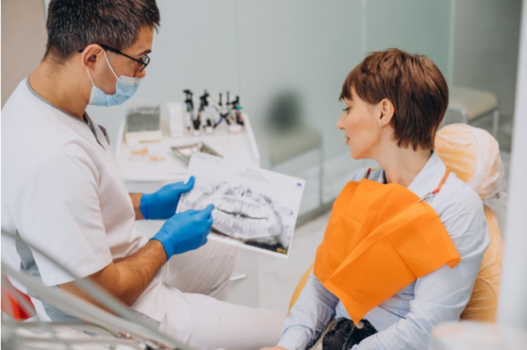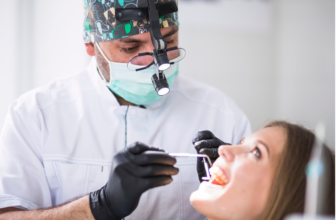Guide to Dental Deep Cleaning
What Is Dental Deep Cleaning?
Dental deep cleaning, also known as scaling and root planing, is a specialized procedure that removes plaque and tartar buildup from below the gumline. This treatment targets areas that standard cleanings can’t reach and is essential for preventing or treating gum diseases like gingivitis and periodontitis.
Types of Dental Deep Cleaning
- Scaling: The removal of plaque and tartar from the tooth surface and beneath the gumline.
- Root Planing: The process of smoothing the tooth roots to help gums reattach to the tooth surface and reduce the risk of bacteria buildup.
- Ultrasonic Scaling: Uses ultrasonic vibrations to break up tartar and plaque, especially beneficial for patients with sensitive teeth or deep gum pockets.
Why Get a Dental Deep Cleaning?
Deep cleaning is crucial for patients who show signs of gum disease or have excessive plaque buildup. It reduces inflammation, prevents the progression of periodontal disease, and helps restore healthy gums and teeth alignment.
Health Symptoms and Reasons to Get Dental Deep Cleaning
Dental deep cleaning is advised if you have:
- Swollen or bleeding gums.
- Persistent bad breath.
- Receding gums or loose teeth.
- Visible tartar buildup below the gumline.
- A diagnosis of gingivitis or periodontitis.
What Type of Health Professionals Perform Dental Deep Cleaning?
- Dentists: Assess oral health and perform deep cleaning treatments, often with support from hygienists.
- Dental Hygienists: Frequently perform the deep cleaning procedures, especially scaling and root planing.
- Periodontists: Specialists in gum health who handle complex cases, especially for advanced gum disease.
What Is the Dental Deep Cleaning Process?
- Examination: The dentist examines the gums and uses a probe to measure pocket depths around the teeth.
- Anesthesia: For patient comfort, a local anesthetic may be applied, especially in sensitive areas.
- Scaling: The hygienist or dentist uses manual or ultrasonic tools to remove plaque and tartar.
- Root Planing: Smoothing of the tooth roots to prevent bacteria from reattaching and reduce gum inflammation.
- Polishing and Antibacterial Rinse: The cleaned area is polished, and an antibacterial rinse is applied to minimize infection risk.
How to Prepare for Dental Deep Cleaning
- Brush and Floss: Ensure your teeth are clean before the appointment.
- Inform the Dentist of Any Medications: Some medications can affect the procedure, so let your dentist know about any current prescriptions.
- Eat a Light Meal: Eating beforehand is recommended, as you may experience temporary sensitivity after the procedure.
- Plan Rest Time: After the procedure, mild soreness or discomfort can occur, so allow time for recovery.
How Often Should Dental Deep Cleaning Be Taken?
For those with healthy gums, deep cleanings are generally only needed once. However, for patients with ongoing gum disease, deep cleanings may be recommended every 3 to 4 months to maintain gum health and prevent disease progression.
What’s the Next Step After Dental Deep Cleaning?
- Follow-Up Appointments: Your dentist may schedule a follow-up to monitor healing and assess gum health.
- Routine Oral Care: Maintain a strict at-home oral care routine with regular brushing and flossing to prevent plaque buildup.
- Maintenance Cleanings: Patients with periodontitis may need more frequent cleanings to prevent relapse.
Risks of Dental Deep Cleaning
While generally safe, dental deep cleaning may cause temporary side effects such as:
- Gum tenderness or soreness.
- Temporary tooth sensitivity.
- Risk of gum infection if aftercare instructions aren’t followed.
- Rarely, gum recession can occur, especially in severe cases.
Dental Deep Cleaning Alternatives
- Regular Cleanings: Suitable for patients without gum disease, focusing on above-the-gumline cleaning.
- Antimicrobial Rinses: Useful for mild gum irritation but not a substitute for deep cleaning.
- Laser Therapy: In some cases, lasers can target bacteria in deep gum pockets, serving as an alternative for some periodontal treatments.
Top 10 Questions Related to Dental Deep Cleaning and Results
- What’s the difference between regular cleaning and deep cleaning?
- Regular cleaning removes plaque above the gumline, while deep cleaning targets areas below the gumline and helps treat gum disease.
- Does deep cleaning hurt?
- The procedure is usually done under local anesthesia, so discomfort is minimal, but you may experience some mild soreness afterward.
- Is deep cleaning necessary if I have gingivitis?
- Yes, deep cleaning can help remove bacteria from below the gumline, addressing inflammation before it progresses to more severe gum disease.
- Can deep cleaning cause gum recession?
- In cases of severe gum disease, deep cleaning may lead to some gum recession, but it’s necessary to prevent further deterioration.
- How long does the deep cleaning procedure take?
- A full mouth deep cleaning typically takes about 1-2 hours but may require multiple visits if the gum disease is extensive.
- Is deep cleaning covered by dental insurance?
- Many dental insurance plans cover deep cleaning, especially if it’s needed to treat gum disease. Check with your provider for specifics.
- What aftercare is needed following a deep cleaning?
- Follow your dentist’s aftercare advice, including using antibacterial rinses, gentle brushing, and avoiding hard or sticky foods.
- Are follow-up cleanings needed after a deep cleaning?
- Yes, regular checkups and possible maintenance cleanings are recommended, especially if you’re at risk for gum disease.
- What are the signs of improvement after a deep cleaning?
- Healthier gums will typically reduce in size, swelling will subside, and bleeding should decrease.
- How soon can I eat after a deep cleaning?
- Wait until the anesthesia wears off, and avoid very hot or crunchy foods for a day to prevent gum irritation.
The Hosst.com Platform uses a Digital Twin to help users manage their health by tracking, organising, and optimising healthcare activities. It provides personalised insights and assists with scheduling checkups, tests, and doctor visits.
Key features include:
- Symptom management: Recommends tests and treatments based on user input.
- Health data tracking: Monitors glucose, blood pressure, and more from health devices or manual inputs. Connects with your favorite apps and health monitors.
- Alerts: Warns of abnormal health signs and suggests corrective actions.
- Lifestyle recommendations: Offers diet, medication, and lifestyle tips based on health trends.
- Test result interpretation: Simplifies complex results and explains what they mean for the user.
- Preventive care: Sends reminders for checkups and suggests actions to prevent illness.
- Health scenario simulations: Predicts potential health outcomes based on current data.
- Product and service finder: Helps users find the right healthcare product or service.
- Doctor visit preparation: Gathers vitals, history, insurance, and questions for productive visits, with easy sharing to doctors.
- User-friendly: Ask in your own words, available on tablets, desktops, and mobile devices.
The platform simplifies health management and improves well-being. Free and easy to use and no installation required, get started today.
Disclaimer: The information provided in these articles is for informational purposes only and is not a substitute for professional medical advice, diagnosis, or treatment. Always consult with a qualified healthcare professional before making any decisions about your health or starting any treatments.
Photo credits Freepik.com






